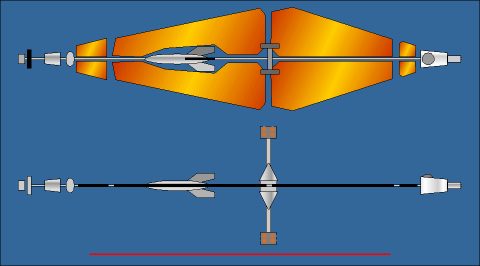
Home - Search - Browse - Alphabetic Index: 0- 1- 2- 3- 4- 5- 6- 7- 8- 9
A- B- C- D- E- F- G- H- I- J- K- L- M- N- O- P- Q- R- S- T- U- V- W- X- Y- Z
Stuhlinger Mars 1962

Stuhlinger 1962
Credit: © Mark Wade
Status: Design 1962. Payload: 70,000 kg (154,000 lb). Gross mass: 360,000 kg (790,000 lb). Height: 150.00 m (490.00 ft).
There were two advanced planning groups at the Army Ballistic Missile Agency: the Research Projects Division, headed by Ernst Stuhlinger, and the Future Projects Office, headed by Hans Koelle (which developed the Project Horizon Army Moon Base and the EMPIRE Mars expeditions).
By 1962 Ernst Stuhlinger's ion-drive Mars expedition had evolved within the Research Projects Division into five 150 m long spacecraft, housing a total crew of 15. The engines accelerated ionized cesium propellant and were powered by a 115 MWT nuclear reactor, which produced 40 MWE and required 4300 sq m of radiators to dissipate waste hear. The triangular radiators gave the spacecraft a flat diamond-shape, with a total mass of 360 metric tons. Three 'A' ships would each be equipped with a 70 metric ton lander, have 120 metric tons of propellant, and remain in Mars orbit. Two 'B' ships would make the round trip, have 190 metric tons of propellant, and no lander.
The mission profile for the low-acceleration vessels involved a 56 day spiraling orbit away from the earth before escape velocity was reached, 146 days transit to Mars, and 21 days to decelerate after Mars capture into a low orbit around Mars. The crew would ride the lander for a 29 day surface stay, before returning to the orbiting B ships for the return to earth. The return trip would mirror the outgoing voyage. During the long trip to Mars and back, the ships would rotate at 1.3 revolutions per minute in order to put the crew under 1/10 G. To protect the crew against radiation, a 50 metric ton graphite shelter was provided aboard each ship. This was 2.8 m in diameter and 1.9 m long, providing tight quarters for three crew. They would have to spend 20 days in this shelter during transit of the Van Allen radiation belts.
Stuhlinger Mars 1962 Mission Summary:
- Summary: Update of 1957 nuclear electric Mars expedition design
- Propulsion: Nuclear electric
- Braking at Mars: propulsive
- Mission Type: low acceleration
- Split or All-Up: all up
- ISRU: no ISRU
- Launch Year: 1975
- Crew: 15
- Outbound time-days: 223
- Mars Stay Time-days: 29
- Return Time-days: 223
- Total Mission Time-days: 475
- Total Payload Required in Low Earth Orbit-metric tons: 1800
- Total Propellant Required-metric tons: 740
- Propellant Fraction: 0.41
- Mass per crew-metric tons: 120
- Launch Vehicle Payload to LEO-metric tons: 454
- Number of Launches Required to Assemble Payload in Low Earth Orbit: 4
- Launch Vehicle: Nova GD-H
Crew Size: 15. Electric System: 40,000.00 average kW.
Family: Mars Expeditions. Country: USA. Propellants: Electric/Cesium. Agency: NASA Huntsville. Bibliography: 49, 591.
Back to top of page
Home - Search - Browse - Alphabetic Index: 0- 1- 2- 3- 4- 5- 6- 7- 8- 9
A- B- C- D- E- F- G- H- I- J- K- L- M- N- O- P- Q- R- S- T- U- V- W- X- Y- Z
© 1997-2019 Mark Wade - Contact
© / Conditions for Use